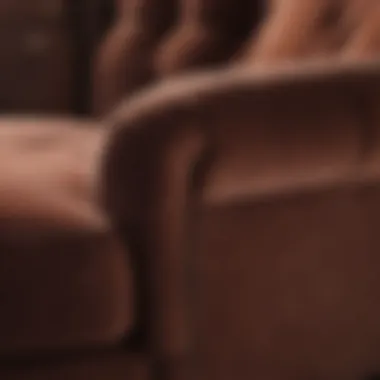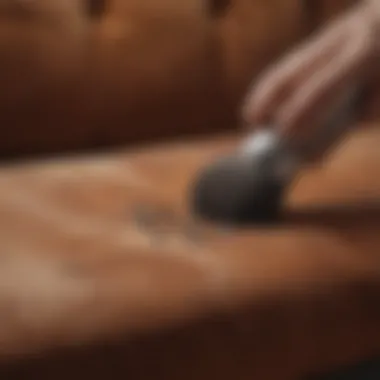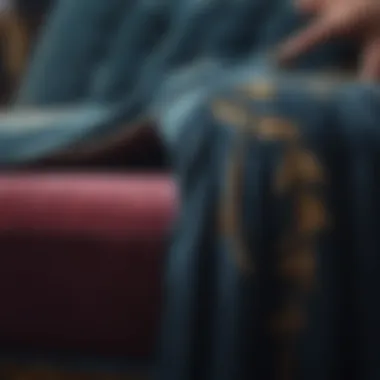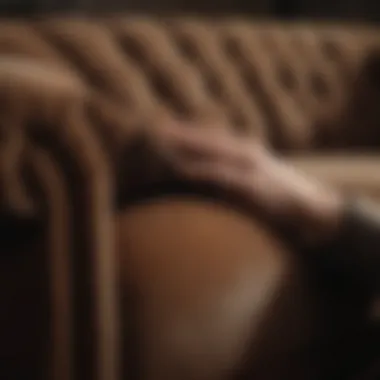Expert Techniques for Repairing Velvet Couch Tears


Intro
Understanding the importance of caring for velvet is the first step in maintaining its allure. This guide is tailored for homeowners and design enthusiasts alike. Here, we discuss actionable steps, from identifying the level of damage, gathering materials needed, to choosing between DIY solutions or enlisting the aid of professionals.
Whether you're hosting a casual gathering or a formal affair, your velvet couch should always look its best.
Design Inspiration
Creating a space that's both functional and stylish promotes a sense of comfort. When it comes to velvet furniture, the design elements that surround and accentuate it can make all the difference.
Current Interior Design Trends
Modern designs now embrace bold textures like velvet for various aesthetics. The current trends favor a blend of minimalism and richness; thus, velvet couches frequently take center stage. Picture this: sleek, contemporary furniture paired with plush velvet accents. It's a juxtaposition that creates visual interest. Popular styles often include:
- Mid-century modern: Characterized by warm hues and geometric shapes
- Scandinavian: Emphasizing simplicity and functionality along with cozy textile choices
- Bohemian: Incorporating vibrant colors and eclectic design that invite artistic expression
Each of these designs showcases velvet beautifully, making it essential to keep your couch in optimal condition.
Color Palettes and Their Effects
Selecting the right colors can transform the entire ambiance of your living space. Velvet comes in a stunning array of hues, from soft pastels to deep jewel tones. Consider how these colors interact with the lighting and other furnishings in your home. Here are a few suggestions:
- Soft blue or green: Create a calming atmosphere, ideal for a restful environment.
- Rich burgundy or gold: These tones impart luxury and warmth, perfect for evening gatherings.
- Neutral tones: Incorporate velvet in shades like grey or beige for versatility, fitting seamlessly into any decor.
When you keep these considerations in mind, your velvet couch becomes not just a piece of furniture, but an integral part of a thoughtfully curated space.
"A well-cared-for velvet couch can become the highlight of a room, blending function with elegance."
Each repair effort should ultimately enhance this visual appeal.
The End
In summary, keeping your velvet couch looking pristine involves a mix of design awareness and practical repairs. Understanding the current trends and effective color palettes adds depth to your living spaces while repairs ensure longevity. Let's delve into the nitty-gritty of methods to repair tears in velvet couches.
Understanding Velvet Fabric
Understanding velvet fabric is crucial when tackling the challenge of repairing tears in couches. Velvet is a distinctive material that has a rich texture and luxurious appearance, making it a popular choice for upholstery. Knowing its unique properties not only helps in making informed repair decisions but also aids in proper maintenance. This fabric is generally woven, which allows it to have both a shimmering and soft texture. Consequently, this elevates the aesthetic appeal of furniture while adding an unparalleled comfort factor.
The benefits of understanding this fabric include the ability to identify the correct repair techniques that won't compromise its quality. Since velvet is prone to some wear and tear, being well-versed in its characteristics becomes essential for any homeowner or interior design enthusiast. This awareness ensures you can select the right tools and methods tailored specifically to velvet's special needs, which ultimately helps maintain the enchanting look of your décor.
Characteristics of Velvet
Velvet stands out due to several defining characteristics, making it unique compared to other fabrics. Here are key features:
- Texture: Its plush surface creates a soft and inviting feel, highly sought after for home furnishings.
- Sheen: Light interacts with velvet differently, creating captivating shifts in color and depth depending on the angle – this quality contributes to its classic elegance.
- Durability: Although luxurious, velvet can be quite resilient. However, its performance highly depends on the fiber content; synthetic velvets often outlast their natural counterparts.
- Varieties: Different types of velvet exist, such as cotton velvet, silk velvet, and polyester velvet, each presenting unique textures and applications.


The interaction of these characteristics can be both beautifying and burdensome, especially when considering potential damage. It’s important to appreciate these nuances when planning to repair or care for velvet upholstery because misuse can lead to irreversible damage.
Common Causes of Tears
Even the most beloved velvet couch can fall victim to tears, often resulting from everyday activities. Understanding the common causes ensures you're prepared to address issues as they arise:
- Wear and Tear: Over time, regular use leads to abrasion, which can weaken the fabric. Areas like armrests or seat cushions are particularly susceptible.
- Pet Damage: Households with pets can see their furniture subjected to scratching or snagging as curious animals explore.
- Improper Cleaning: Utilizing the wrong cleaning products or methods could result in fabric weakening or distortion, leading to tears.
- Heavy Objects: Placing heavy items on furniture can stretch the fabric, causing pressure points that may rip over time.
Recognizing these causes allows homeowners to take preventative steps, protecting their investments and ensuring a beautiful and functional living space for years to come.
Assessing the Damage
In the realm of upholstery, particularly with a fabric as sophisticated as velvet, assessing the damage is like reading the tea leaves – it’s not just important, it's essential. Before you roll up your sleeves and dive into repairs, understanding the extent of the damage helps set the stage for an effective remedy. This phase can save you from a half-baked job that might worsen the issue. It’s vital to take a moment, breathe, and really look at what you're dealing with.
Evaluating Tear Size
When evaluating tear size, the first step is to be honest with yourself. A small tear might seem manageable, but in velvet, even a minor split can rapidly escalate if untreated. Measure the tear carefully; this isn’t a guessing game. Is it a tiny snag or a long gash? Get a ruler, and for good measure, jot it down. What kind of tear are we talking about? Here’s a brief breakdown of common sizes:
- Small (less than an inch): Generally repairable with minimal tools.
- Medium (1 to 3 inches): May require a bit of patchwork or sewing.
- Large (more than 3 inches): Might necessitate more intricate repair methods or professional help.
An accurately sized tear gives you invaluable insight into what materials and methods will best suit the task at hand. Remember, dealing with size isn’t just about the current damage; it’s about avoiding future headaches.
Identifying Fabric Integrity
Next up on the checklist is identifying the fabric integrity of your couch. Velvet may look like a delicate fabric, but it boasts an impressive toughness. However, tears can compromise this strength, thus revealing underlying issues. To parade around your velvet piece like it’s still the belle of the ball, you have to assess how well the fabric has held up.
Start by running your fingers over the surrounding fabric. Is it smooth or does it feel distinctively rough? Besides the tear, check for areas of fraying or thinning. If your velvet feels like dry grass underfoot, you may want to rethink your repair options.
- Check the weave: Inspect whether any threads are pulling away or are loose.
- Look for discoloration: Fading can denote previous attempts at cleaning or damage which could affect repair methods.
"A little diligence during the assessment phase can save you from a multitude of future setbacks."
Gathering this thorough insight will elevate your repair work from a simple fix-it job to a full-blown restoration. When you know precisely what you’re working with, whether you decide to take the DIY route or call a professional, you'll be making informed decisions that enhance the life and beauty of your velvet couch.
Preparing for Repairs
Repairing a tear in a velvet couch might seem daunting, but properly preparing for the task sets the stage for a successful outcome. Skipping steps or diving headfirst without a plan can lead to further damage or sloppy repairs. The process of preparing for repairs involves not just gathering the right tools and materials but also understanding the nature of the damage and the fabric itself.
Significance of Preparation
Effective preparation increases the chances of achieving a seamless repair. For homeowners, this step ensures that whatever method chosen—whether a DIY approach or calling in the pros—can be executed efficiently and with confidence.
One might liken it to cooking a gourmet meal; it’s essential to have all your ingredients ready before you start mixing and sautéing.
Key Elements to Consider
- Assess the Situation: Before anything else, take a good look at the tear. Note its size, location, and whether the fabric is fraying or if adjoining areas need attention as well. This assessment will help in choosing the right repair technique.
- Ideal Environment: Ensure that you have a well-lit area to work in. A clutter-free zone allows for smooth movements and keeps distractions at bay.
- Time Management: Allocate enough time for the repair. Rushing through might result in corners being cut and a less-than-ideal finish.


Benefits of Proper Preparation
- Increases likelihood of a successful repair.
- Saves time by reducing potential make-work situations.
- Provides a more aesthetically pleasing outcome that maintains the elegance of the velvet.
"An ounce of prevention is worth a pound of cure." — Benjamin Franklin
To ensure the repair process flows as smoothly as a newly ordered wine, dive deep into gathering necessary tools and choosing the appropriate repair materials right at the start.
DIY Repair Techniques
When it comes to addressing tears in your velvet couches, mastering DIY repair techniques can be a lifesaver. Not only does it save on costs, but it also gives you an opportunity to take matters into your own hands, preserving the beauty and comfort of your furniture. These skills can be particularly useful since velvet, with its luxurious feel and elegant appearance, can also be a magnet for damage. Knowing the ins and outs of DIY repairs enables you to tackle minor issues before they balloon into larger, more costly problems.
Sewing the Tear
Sewing a tear in velvet might sound daunting, but with patience and the right technique, it's a straightforward process. First, it's essential to choose a thread that matches your upholstery, ensuring the repair blends seamlessly with the fabric. You can use a fine needle to avoid leaving noticeable holes.
Begin by gently pulling apart the torn edges of the fabric. Align them as closely as possible, then insert the needle from the underside of the fabric, keeping everything hidden from view. A simple running stitch or a backstitch can reinforce the area. Pay attention to the tension – tightening too much can cause puckering, while being too loose won't provide the required stability. After you've sewn the tear together, tie off the thread securely, and trim any excess.
Using Fabric Adhesives
Fabric adhesives offer another viable method for repairing velvet tears. These adhesives are specifically designed for fabric bonds, providing flexibility that typical glues lack. They allow for a strong hold while preventing stiffness, which is crucial for maintaining the couch's original feel.
Before applying, clean the area around the tear to ensure a solid bond. Apply the adhesive according to the manufacturer's instructions, making sure to use just enough to cover the area without excess oozing out. Press and hold the fabric together for the recommended time. Drying time varies, so patience is key. A success with adhesives is that they can also be used in conjunction with other methods, adding extra strength to your repair.
Applying a Patch
Patchwork can be an excellent choice for larger tears or areas of damage in velvet upholstery. This technique not only hides the imperfection but can also serve to enhance the aesthetic of your couch. It's a bit like a breath of fresh air for your furniture. When selecting a patch, aim for a velvet fabric that closely matches the original and is in a similar medley of colors.
To apply the patch, cut it slightly larger than the tear itself. Use fabric adhesive or stitching methods to secure the patch in place, carefully blending its edges with the surrounding fabric to create a seamless flow. If you choose to sew, use a whip stitch to secure the patch more firmly. After applying, allow it to sit undisturbed for proper adhesion.
Patchwork can even serve as a decorative element, adding new life and charm to your couch, ultimately showcasing your creativity.
By understanding and utilizing these DIY repair techniques, homeowners can effectively address the inevitable mishaps that befall velvet couches. Each method described clings to the central theme of maintaining the integrity of your velvet pieces, ensuring that they remain a valued part of your home.
Seeking Professional Help
When it comes to repairing tears in velvet couches, sometimes we reach a point where the damage is just beyond our DIY abilities. This is where seeking professional help becomes paramount. There’s no denying the unique beauty and texture of velvet, yet its intricate nature can complicate repairs. Engaging an expert not only ensures that the repairs are done right but can also save you time and frustration.
When to Consider a Professional
Recognizing when to call in the pros can save your couch — and your sanity. Here are some scenarios where professional assistance is beneficial:
- Large Tears or Rips: If your couch has sizable tears, attempting to fix it yourself could lead to further damage. A seasoned upholsterer can not only repair the tear but can also restore the overall integrity and appearance of the velvet.
- Fabric Integrity Concerns: If the velvet itself is damaged or fraying around the tear, it’s a clear sign that professional intervention is necessary. They possess the knowledge to assess fabric health and can determine if the entire section needs to be replaced.
- Unusual Tear Patterns: Complex or irregular tear patterns, such as those from pets or unintentional mishaps, might require specialized repair techniques. Experts are equipped with the tools and skills to tackle these unusual challenges.
- Mismatch of Dye Lot: If you need to replace fabric or die sections to match the original, professionals have access to various dye lots and materials that can be nearly indistinguishable from the original fabric.
"When in doubt, lean on the experience of a professional. You’ll prevent further damage and achieve a result that’s aesthetically pleasing."


Selecting a Upholstery Expert
Finding the right person for the job can feel daunting. Here are some steps to ensure you choose a qualified upholstery expert:
- Check Credentials: Look for professionals with certification or training in upholstery. Their education and experience can indicate their level of expertise.
- Review Portfolios: Ask to see before-and-after photos of previous work. A good portfolio can provide insight into their skill level and aesthetic.
- Read Reviews: Websites like Yelp or Angie’s List can give you firsthand accounts from previous clients. Consistency in positive feedback is a good sign of reliability.
- Request Quotes: Different experts may charge varying rates based on their skill and geographic location. Obtaining several quotes can help you gauge the average cost and avoid surprise fees down the line.
- Ask about Guarantees: A reputable professional should stand behind their work, offering some form of guarantee or warranty on repairs. This can provide peace of mind and assurance that they are invested in customer satisfaction.
By carefully considering when to go for professional help and ensuring you choose the right expert, it will not only preserve the beauty of your velvet couch but also extend its life, keeping your living space looking sharp and inviting.
Post-Repair Care for Velvet
Maintaining a velvet couch post-repair isn't just a good idea – it's crucial to ensure its longevity and aesthetic appeal. Once you've addressed the tears or damages, the subsequent care plays a significant role in preserving your hard work. Ignoring this phase could lead to further damage and degradation, diminishing the very beauty and elegance the fabric brings to your home.
The importance of post-repair care lies in a few key areas:
- Restoration of Appearance: Proper cleaning and maintenance can restore the vibrant color and plush texture of the velvet after it has been subjected to repairs.
- Enhanced Durability: Implementing care techniques effectively increases the lifespan of the fabric, making it more resistant to future wear and tear.
- Preserving Repair Integrity: Ongoing care helps in preserving the strength and quality of the repairs made, ensuring they hold up over time.
Moreover, understanding the right cleaning and preventative techniques can dramatically impact how your couch withstands daily usage.
Cleaning Techniques
When it comes to cleaning velvet, a gentle touch is recommended. Here's how to effectively clean your couch without compromising the fabric:
- Vacuuming: Use a soft brush attachment to vacuum your couch regularly. This removes dust and crumbs that can cause the fabric to wear down over time.
- Spot Cleaning: For stains, it’s essential to act quickly. Blot the stain with a clean, dry cloth by pressing down gently. Avoid rubbing, as this can push the stain deeper into the fibers.
- Steam Cleaning: If your couch allows it, light steam cleaning can help refresh the fibers. Keep the steamer at a distance to avoid water damage.
Preventative Maintenance
Taking proactive steps can save you a lot of grief in the long run. Here’s what you can do:
- Use Fabric Protector: Consider applying a protective spray made for upholstery to guard against stains and spills. Check for compatibility with velvet before purchase.
- Rotate Cushions: If your couch has removable cushions, rotate them regularly. This helps to evenly distribute wear and leads to a more uniform look.
- Avoid Direct Sunlight: Position your couch away from windows or use sheer curtains. Sunlight can fade colors and degrade the fabric over time.
- Keep Pets Off the Couch: If possible, train your pets to stay off or use covers when they’re around. Pet claws can easily catch on velvet and create new tears.
By maintaining your velvet couch post-repair through these cleaning techniques and preventative measures, you're not just keeping the couch in its best shape – you're also preserving the environment of your home, enhancing the comfort and elegance that velvet brings.
The End and Final Thoughts
Tears in velvet couches can seem daunting, but addressing them is essential for both aesthetics and longevity. Understanding the methods for repairing these tears equips homeowners and design enthusiasts with the necessary skills to maintain and restore their cherished furniture pieces. In this article, we’ve explored DIY techniques, sought professional help when necessary, and discussed post-repair care practices. Each of these elements comes together to ensure the vibrancy of velvet upholstery remains intact for years.
Summarizing Repair Options
A quick recap of the methods covered is in order:
- Sewing the Tear: This technique is best for smaller, clean-cut tears. Using a needle and thread that matches the fabric, one can achieve a nearly invisible repair. Ensure to knot securely to avoid future fraying.
- Using Fabric Adhesives: Excellent for those who prefer a simpler approach. Apply adhesive sparingly to prevent visibility and follow the manufacturer’s instructions for curing time.
- Applying a Patch: For larger or more complicated tears, a patch offers a reliable solution. Choose a fabric that matches the original, cut it to size, and secure it firmly in place.
Long-term Fabric Care Strategies
To keep your velvet looking its best post-repair, consider these strategies:
- Regular Cleaning: Use a soft brush to remove dust. Velvet should be cleaned regularly to uphold its luxurious appearance. Avoid overly wet methods that can damage the fabric's unique texture.
- Immediate Attention to New Damage: Whenever minor tears or stains occur, address them promptly. Quick action can prevent the issue from worsening, saving you time and effort in the long run.
- Mindful Maintenance: Avoid placing heavy items on velvet surfaces or exposing them to direct sunlight for extended periods, as this can cause fading.
"Taking care of your furniture isn’t just about keeping it clean; it’s about preserving your investment and style for the future."
By embracing these techniques and practices, you can safeguard your velvet investments. The allure of velvet is worth the care it requires, ensuring it remains a centerpiece in your living space.















